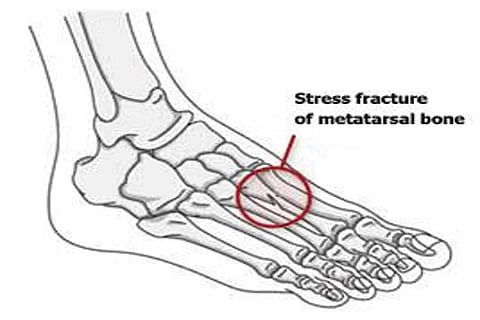

Chennai
The bone is dynamic tissue with constant bony absorption and deposition stimulated by bone stress. Micro damage is a normal process that occurs with activity and is correlated with intensity and the amount of impact.
The body usually heals the micro damage before it can accumulate, and during the healing process, the body lays down extra bone to strengthen and prevent future injuries. This process is how athletes can improve their bone density. Unfortunately, there are times when athletes overwhelm their body’s ability to heal the bone stress and the damage accumulates to the point of localised inflammation or fracture.
“The most common of these factors that I see in the office are training errors, too much too soon, and inadequate recovery time, but all of them need to be considered. The most common sites for stress fractures in runners are the shin (tibia) and foot bones (metatarsals and tarsals). Stress fractures typically present gradually but can also start with sudden pain. The factors that are correlated with increased bony damage include: high running mileage, training errors, low bone density, high ridged arches, inappropriate foot wear, leg length discrepancies, and other malalignments,” said Dr. Vivek A N, Consultant, Bone and Joint, Fortis Malar Hospital.
Athletes sometimes are confused when a stress fracture presents acutely. Early inflammation and stress reactions can be pain free until the fracture occurs. Localised bony pain and tenderness is the hallmark of stress reactions and stress fractures. The area of pain is typically small and about the size of a half dollar. This localisation is in contrast to shin splints, where the pain is over a much broader area such as the size of a dollar bill.
Medicos say that the process a physician will take to diagnose a stress fracture involves obtaining an accurate history, performing a physical examination, and typically imaging. The most common initial images obtained are x-rays. They are quick, easy, and relatively inexpensive, but especially in the first three to four weeks may not be diagnostic.
For cases where the diagnosis is in question or a diagnosis is needed quickly, an MRI can be obtained and offers valuable information. Recent studies show that use of musculoskeletal ultrasound can help with stress fracture diagnosis. The treatment of stress fractures depends on the location and severity of the injury.
“Low-risk stress fractures require a period of rest from any activity that causes pain followed by a gradual return to training. If the athlete has pain with daily activities, braces, boots, and crutches can be used to limit the pressure through the injured area and may allow for more rapid healing. Total time for healing also depends on the location and severity and ranges from as little as three weeks to three months or more,” added Dr Vivek.
Low-risk stress fractures, which are the most common type, typically heal completely with unloading the injured bone. Factors that influence how fast individuals heal bone stress injuries include: genetics, diet including calcium intake, and hormones.
Healing time is also dependent on how much the athlete unloads the stressed pain. To prevent delay in healing, any activity that causes pain should be avoided. As long as they are pain free with walking, triathletes can often swim and bike while they are healing their stress fracture.
There are locations that are considered high risk such as the patella (kneecap), the proximal femur at the hip (thighbone), the front of the tibia (shin bone), and certain bones in the foot. These locations are at a risk for healing slowly, not healing at all, or for being recurrent. Your doctor will take extra precautions with managing these injuries.
It is important to take time and allow the injury to heal fully to limit the chance of recurrence. During healing and early in your return to training, it is also appropriate for your doctor to investigate why your injury occurred in the first place. The evaluation should include biomechanics, gait, strength, flexibility, hormone status, nutrition, footwear, as well as your training plan.
Visit news.dtnext.in to explore our interactive epaper!
Download the DT Next app for more exciting features!
Click here for iOS
Click here for Android